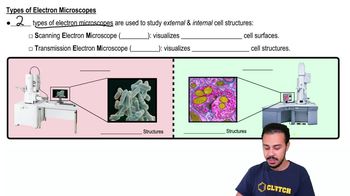Microscopes definitions Flashcards
 Back
BackMicroscopes definitions
1/15
Terms in this set (15)
- MicroscopeAn optical instrument used to visualize objects too small to be seen by the naked eye, such as cells.
- Light MicroscopeA tool that uses light to magnify small objects, suitable for viewing most cells and bacteria.
- Electron MicroscopeA powerful tool using electrons for high magnification, capable of visualizing viruses and molecules.
- Scanning Electron MicroscopeAn electron microscope used to visualize external cell surfaces and structures.
- Transmission Electron MicroscopeAn electron microscope used to visualize internal cell structures and organelles.
- MagnificationThe process of enlarging the appearance of an object using optical instruments.
- Eukaryotic CellsCells with a nucleus, generally larger than prokaryotic cells, including most plant and animal cells.
- Prokaryotic CellsCells without a nucleus, generally smaller, including most bacteria and archaea.
- VirusesMicroscopic infectious agents that can only be visualized with electron microscopes.
- ProteinsLarge molecules essential for cell structure and function, visible with electron microscopes.
- LipidsMolecules that form cell membranes, visible with electron microscopes.
- AtomsThe smallest units of matter, visualized using electron microscopes.
- OrganellesSpecialized structures within cells, visible with transmission electron microscopes.
- ArchaeaA domain of single-celled microorganisms, similar to bacteria, visible with light microscopes.
- BacteriaSingle-celled microorganisms, visible with light microscopes, smaller than eukaryotic cells.


